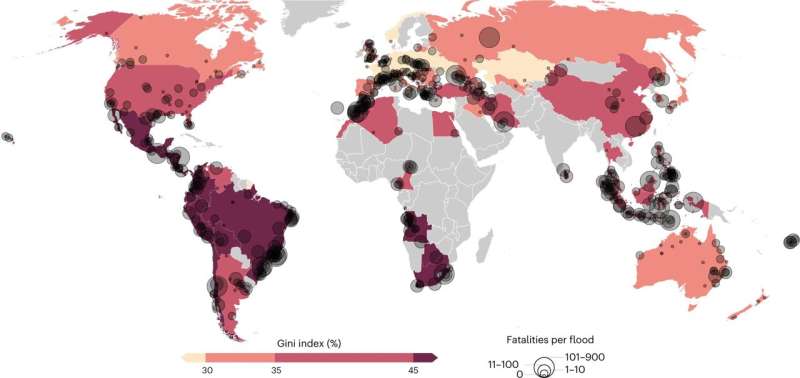This article has been reviewed according to Science X's editorial process and policies. Editors have highlighted the following attributes while ensuring the content's credibility:
fact-checked
peer-reviewed publication
trusted source
proofread
Wide income gaps linked to higher mortality rates during flood disasters

A new study led by researchers from Uppsala University shows a clear link between economic inequality and mortality during severe flood disasters. Countries with an uneven distribution of income had many times higher mortality rates compared to countries with more evenly distributed income levels. The results are published in Nature Sustainability.
"We find this alarming, especially as we can expect more extreme precipitation patterns in a changing climate. The increasingly unequal distribution of economic resources within countries deserves more attention within disaster risk reduction—among researchers as well as authorities and governments," explains Sara Lindersson, doctoral student at the Centre of Natural Hazards and Disaster Science (CNDS) and first author of the study.
The researchers conducted an analysis of over 500 major flood disasters in 67 middle- and high-income countries over the last three decades. The aim of the analysis was to determine whether the link between economic inequality and mortality remained after controlling for other factors such as GDP per capita and population size in affected areas.
The results show a clear link between economic inequality and mortality in large-scale flood disasters. The median mortality rate is 26 times higher in countries with an unequal distribution of income, compared to countries with more equally distributed income levels. Countries in Africa, Asia and the Americas had the highest number of deaths and mortality rates per flood disaster, while Europe and Oceania lost fewer lives.
The researchers analyzed geocoded data on flood mortality along with global population maps and national economic data. Through a statistical cross-country comparison, the researchers found that a three-percentage-point increase in income inequality, which has been a typical development in these countries over the study period, was associated with an average death-rate increase of 16%. The researchers also identified that this link was even stronger for the richest countries in the sample group.
"Although this type of broad comparative study inevitably involves simplifications and our data cannot establish causality, that is, show exactly how one thing leads to another, the results underline how inequality plays a more central role than GDP in explaining flood mortality," continues Lindersson.
Previous research has shown that economic inequality can affect flood vulnerability in several ways. High levels of economic inequality often mean that a large proportion of the population lives in poverty. These individuals often lack the necessary resources to evacuate in time. This economic misallocation can result in segregated urban environments, which can also increase vulnerability to disasters. Resources, services and protective infrastructure are concentrated in high-income areas, while low-income areas are left behind and thus become more vulnerable.
The authors highlight the disaster in New Orleans following Hurricane Katrina as an example of how inequality can lead to a fatal outcome, as a range of factors exacerbated mortality in the city's low-income areas. The most severe flooding occurred in these low-income areas after the levees failed. People in these areas also had limited access to cars or other forms of transportation, which meant that many could not evacuate in time. In addition, many people lived in homes that were very vulnerable to flooding, such as mobile homes. Finally, these areas suffered from severe air pollution after the flood, due to their proximity to the city's industrial areas.
"Our findings highlight the importance of analyzing not only the vulnerability of poor countries, which is acute, but also societal factors in rich countries that drive vulnerability. This is important for developing more effective disaster risk reduction strategies that identify and address root causes," concludes Lindersson.
More information: Sara Lindersson et al, The wider the gap between rich and poor the higher the flood mortality, Nature Sustainability (2023). DOI: 10.1038/s41893-023-01107-7




















